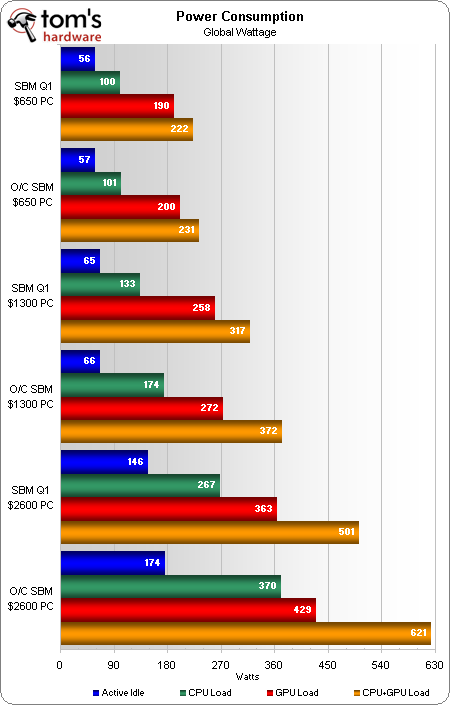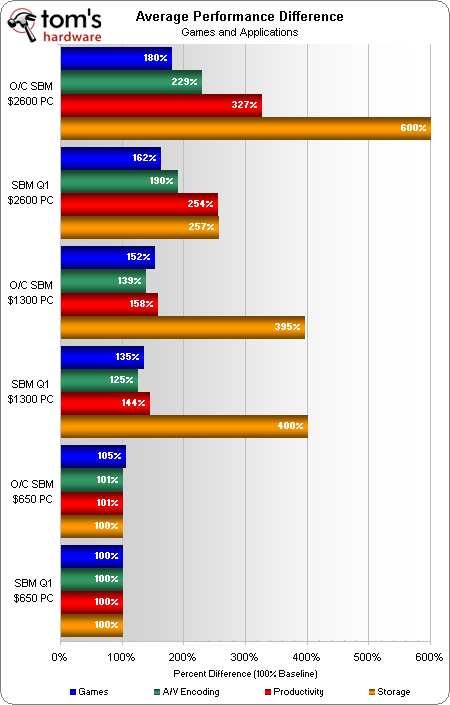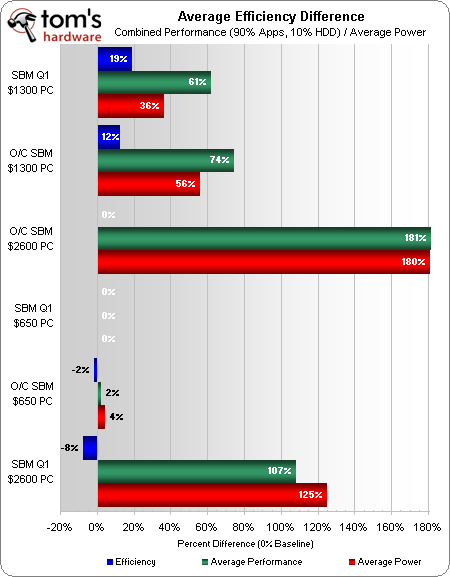System Builder Marathon, March 2012: System Value Compared
Power And Efficiency
Power consumption is one place where slower dual-core processors shine, which gives Paul's effort a chance to top our corresponding chart, where lower numbers are better.
On the other hand, my Core i7-3930K consumes more than two times the idle power of Don's Core i5-2400, even though it only employs two additional cores.
Since efficiency compares work to energy, we first collect performance averages for all tests to determine how much more gets done on the faster systems. Using the slowest configuration as our 100% baseline makes this measurement easy.
Dividing average performance by average power would give us average efficiency, but we weighted our performance charts to account for the 10% maximum amount of time a user might spend waiting for various files to load. The baseline from these calculations starts at 100%, but since nothing is 100% efficient we move the baseline to 0% by subtracting one from the results.
Surprisingly, the $2600 PC actually reaches baseline efficiency when it's overclocked, even though moderate CPU voltage increases were required. The $1300 build shines brightest however, combining an efficient Sandy Bridge quad-core processor with AMD’s moderately-efficient Radeon HD 7970 graphics card.
Current page: Power And Efficiency
Prev Page Benchmark Results: Productivity Next Page Three Different Goals, One Value ConclusionGet Tom's Hardware's best news and in-depth reviews, straight to your inbox.
-
sonexpc Looks like $650 PC can do almost everything smoothly ! Even most of the game can get over 40fps...Reply
which is not bad... for Just $650 ...So the first piority for gaming PC is still the Video card! -
shoot you I always love seeing the System builder articles (even though I cant build one myself for now hahahaha).Reply
Great as always. It sad that the Nvidia GTX 680 has yet to be considered due to availability and pricing issues hehehehe.
-
iamauser Translation: we don't actually stand behind any of these builds as being worthwhile to emulate.Reply -
Crashman iamauserTranslation: we don't actually stand behind any of these builds as being worthwhile to emulate.The $650 and $2600 PC builders loved their machines, it's just hard to recommend either of those to "everyone" or even "most people" since most of the readers really want $800-1200 machines.Reply -
MMO Fan CrashmanThe $650 and $2600 PC builders loved their machines, it's just hard to recommend either of those to "everyone" or even "most people" since most of the readers really want $800-1200 machines.It's hard to recomend them because they just are not real good for the large outlay of cash as in the money could have been spent on better parts but instead was spent on "balancing" and pleasing the TH memebers.Reply -
Wave Fusion I'd love to build a PC with a beefy GPU someday.Reply
But coming from a notebook background, I more or less have to start from scratch.
I can use my old mouse, and my TV as a monitor. But on top of the estimated build costs listed, I also need the OS, keyboard, and likely other misc. odds and ends.
$200 ($100 OEM) for Windows 7 is brutal.
I also don't want to waste time on a desktop that only has a GPU advantage over the notebook.
Desktop upgrades over even a mobile i7 is still pricey.
Since I know my 2720QM uses the same die as desktops; it'd be swell if I could just yank it out; plug it in a desktop board and call it a 2600k. In a desktop it wouldn't have to stay in a 45W TDP
But.. *sigh*.. the parts are locked, the sockets don't match; and a real life desktop carbon copy of my notebook is out of my budget atm.
--
If I could find a way to attach a 7870 to my notebook motherboard, I wouldn't have a problem with the frankenstein-ish creation.
The 6670 just doesn't cut it sometimes -
MMO Fan Wave FusionI'd love to build a PC with a beefy GPU someday.But coming from a notebook background, I more or less have to start from scratch.I can use my old mouse, and my TV as a monitor. But on top of the estimated build costs listed, I also need the OS, keyboard, and likely other misc. odds and ends.$200 ($100 OEM) for Windows 7 is brutal. I also don't want to waste time on a desktop that only has a GPU advantage over the notebook.Desktop upgrades over even a mobile i7 is still pricey.Since I know my 2720QM uses the same die as desktops; it'd be swell if I could just yank it out; plug it in a desktop board and call it a 2600k. In a desktop it wouldn't have to stay in a 45W TDPBut.. *sigh*.. the parts are locked, the sockets don't match; and a real life desktop carbon copy of my notebook is out of my budget atm.--If I could find a way to attach a 7870 to my notebook motherboard, I wouldn't have a problem with the frankenstein-ish creation.The 6670 just doesn't cut it sometimesAny Desktop CPU this side of C2Duo will substancially out perform any Laptop CPUReply -
Crashman MMO fanIt's hard to recomend them because they just are not real good for the large outlay of cash as in the money could have been spent on better parts but instead was spent on "balancing" and pleasing the TH memebers.I'll explain this the way I did in your other $2600 PC comments. You're simply wrong. I can't help you understand why someone would want a PC that performs well in multiple areas. I can't help you understand why someone would want their PC to be quiet. I can't help you to understand why someone would want their PC to store more applications on the faster device. I can't help you to understand these things because you have already rejected them. Your prejudice excludes any "balanced" analysis.Reply
But at least you're fairly nice about it. -
MMO Fan CrashmanI'll explain this the way I did in your other $2600 PC comments. You're simply wrong. I can't help you understand why someone would want a PC that performs well in multiple areas. I can't help you understand why someone would want their PC to be quiet. I can't help you to understand why someone would want their PC to store more applications on the faster device. I can't help you to understand these things because you have already rejected them. Your prejudice excludes any "balanced" analysis.But at least you're fairly nice about it.7970 is more than "well" it is the best of the best and Fractal Design Define R3 is $100 or some $30 less than the P280 and performance better these two points I made are just for starters. If you will I could go on and build a far better machine for $2600 but you seem to think this TH $2600 "performance" build is the best when it is far from it.Reply




